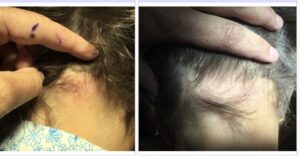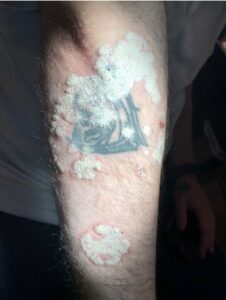 Psoriasis is a condition in which skin cells build up and form raised, red, itchy and scaly patches or spots on the skin. It’s caused by the body making skin cells too quickly, causing the skin cells to pile up. Plaque psoriasis is the most common type of psoriasis. In fact, about 80% to 90% of people living with psoriasis get plaques, thick, scaly patches.
Psoriasis is a condition in which skin cells build up and form raised, red, itchy and scaly patches or spots on the skin. It’s caused by the body making skin cells too quickly, causing the skin cells to pile up. Plaque psoriasis is the most common type of psoriasis. In fact, about 80% to 90% of people living with psoriasis get plaques, thick, scaly patches.
Patches may appear anywhere on the skin, but most likely on the knees, elbows, lower back and scalp, with intense itching. Some people notice that their skin stings, burns or feels painful and tight. Most people who get psoriasis, have it for life—except for children who may have guttate psoriasis, a type of psoriasis that shows up on the skin as red, scaly, small, teardrop-shaped spots, and tends to go away.
What Is Psoriasis?
Psoriasis is a long-lasting autoimmune skin condition where the body’s immune system goes into overdrive and mistakenly attacks healthy tissues. This leads to an excessive production of skin cells, causing the formation of thick, silvery scales and dry, red, and sometimes painful patches. This happens because the life cycle of skin cells speeds up and dead skin cells accumulate.
Typically, these scales appear on certain parts of the body like the joints, elbows, knees, hands, feet, face, and scalp. It is less common for scales to develop on nails and in the mouth. According to the Centers for Disease Control and Prevention (CDC), more than 6 million Americans are affected by various types of psoriasis.
Common Types Of Psoriasis
At The Art of Skin Dermatology, we specialize in treating various forms of psoriasis, including the most common types such as plaque psoriasis, guttate psoriasis, pustular psoriasis, and inverse psoriasis. If you would like more information about these different types of psoriasis or if you are interested in scheduling a treatment with our experienced dermatologists, please don’t hesitate to contact us. We are here to help you find relief and manage your psoriasis effectively.
Plaque Psoriasis
Plaque Psoriasis, the most prevalent type of psoriasis, is easily recognizable by its periodic flares of distinct red patches on the skin. These patches are covered with inflamed white-silver scales, known as plaques. Commonly found on the knees, elbows, lower back, and scalp, these plaques can be itchy, painful, and prone to cracking and bleeding.
Psoriatic Arthritis
Psoriatic Arthritis, affecting around 30 percent of psoriasis sufferers, is an inflammatory arthritis that occurs alongside psoriasis. This chronic autoimmune disease occurs when the body’s immune system mistakenly attacks healthy tissue in the joints and skin. The result is joint pain, stiffness, and swelling, which can remain dormant until triggered by external factors.
Inverse Psoriasis
Inverse Psoriasis, also known as intertriginous psoriasis, manifests as red lesions within skin folds. These lesions may appear shiny and smooth and are commonly found in the genital area, upper thighs, groin, armpits, and breasts. In some cases, individuals with inverse psoriasis may also develop other forms of psoriasis, such as plaque psoriasis, in different areas of the body.
Guttate Psoriasis
Guttate Psoriasis presents as small dot-like lesions and is often seen in children and young adults. It can be triggered by a streptococcal infection and is the second most common form of psoriasis after plaque psoriasis. According to the National Psoriasis Foundation, over 10 percent of people with psoriasis develop guttate psoriasis at some point.
Pustular Psoriasis
Pustular Psoriasis is characterized by white pustules surrounded by red skin. These blisters, filled with pus consisting of white blood cells, may resemble an infection, causing patients to feel unwell, lethargic, itchy, and experience loss of appetite or fever. However, pustular psoriasis is not contagious or infectious and can occur on any part of the body, although it is most commonly found on the hands and feet.
Psoriasis Symptoms
The symptoms of psoriasis can vary greatly depending on the type of psoriasis and the individual. Some types may only cause small patches of lesions, while others can cover large areas of the body, similar to rosacea. When people think of psoriasis symptoms, they often imagine the scaly plaques that cover red areas of skin, known as plaque psoriasis. However, there are many different types of psoriasis, each with its own unique appearance and symptoms.
Each type of psoriasis is characterized by a distinct rash and is accompanied by additional symptoms. The most common symptoms experienced by psoriasis patients include raised and inflamed patches that are red in color, white or silver scales on the red patches, dry skin that cracks and bleeds, soreness around the affected areas, swollen or painful joints, red spots or lesions on the skin, white pustules, and itching or burning of the skin within and around the patches.
These symptoms often occur in cycles for individuals with psoriasis. They may experience severe symptoms one week and then have them disappear the next. Sometimes, the symptoms may completely go away, but can be triggered and return. If you have psoriasis and are seeking treatment options, consider contacting The Art of Skin Dermatology for assistance from experienced dermatologists.
Psoriasis Triggers
Triggers that can worsen psoriasis symptoms vary greatly and are unique to each patient. These triggers can also change over time. Common triggers include high stress, alcohol consumption, bodily injuries, certain medications, and infections. Our dermatologists can help you identify and manage your specific triggers. Schedule an appointment today.
Psoriasis Severity
Psoriasis severity can range from mild to severe, and treatment options may depend on the severity. Severity is determined by the amount of affected skin on the body. For reference, the entire hand is equal to about 1 percent of the body surface area.
- Mild psoriasis covers less than 3 percent of the body
- Moderate psoriasis covers 3 percent to 10 percent of the body
- Severe psoriasis covers more than 10 percent of the body
- Severity also takes into account how much the condition affects your quality of life.
Psoriasis Causes
The exact causes of psoriasis are still unknown, but research suggests that genetics and the immune system play a role. Psoriasis is an autoimmune condition where the body’s T-cells mistakenly attack healthy skin cells, leading to the development of plaques and inflamed areas. Certain genetic traits can also increase the likelihood of developing psoriasis, especially if there is a family history. However, this may not be the case for everyone.
How Is Psoriasis Diagnosed?
To determine if a person has psoriasis, doctors typically conduct a physical examination and may perform a biopsy. In most cases, dermatologists can diagnose psoriasis by simply examining the affected area, as the symptoms are usually visible to the naked eye. However, if the symptoms are unclear or if confirmation is needed, a small sample of the affected skin may be biopsied for further analysis.
